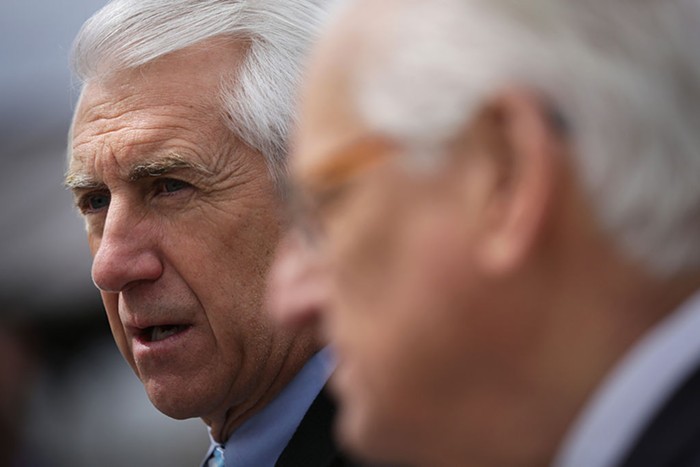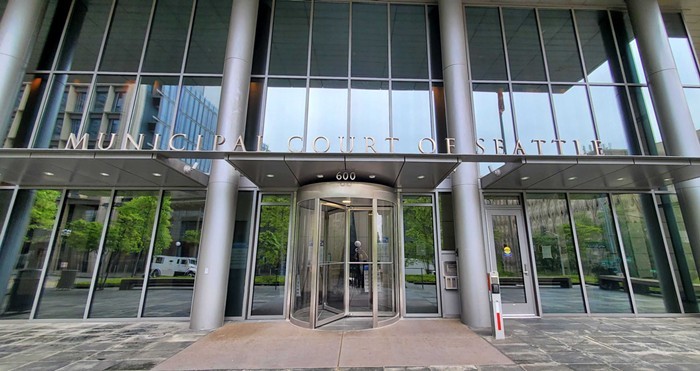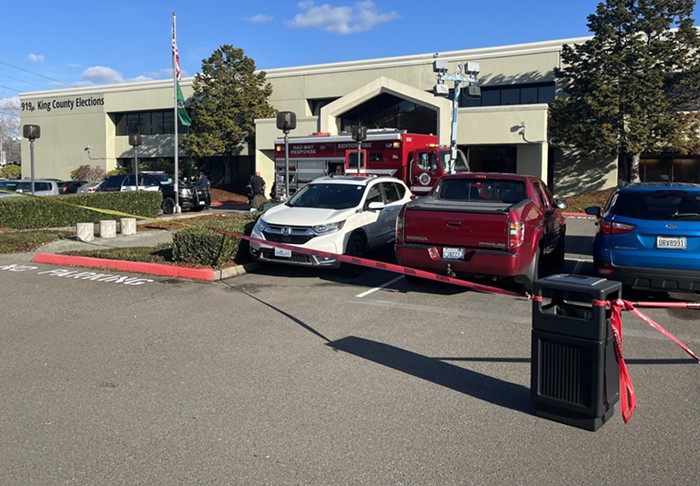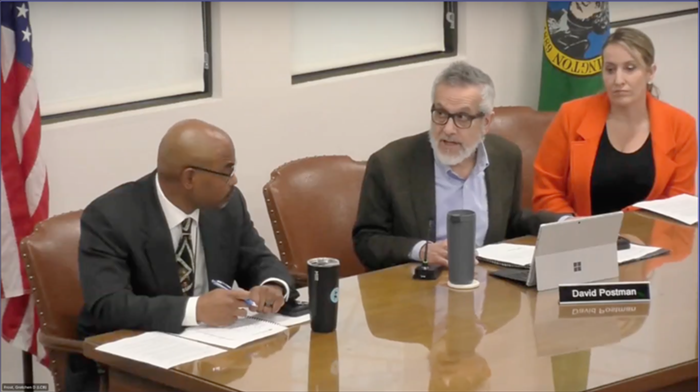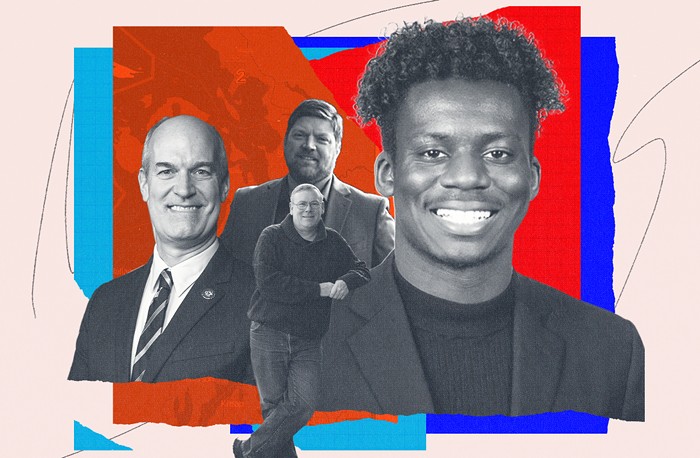I thought I knew where I was. I saw Griffith Park, I saw the Hollywood Bowl, I saw... wait, no. We flew over six parks that looked like Griffith Park. The plane dipped and turned. Which way was the ocean? I gave up and wondered what I usually wonder when I fly into a mostly unfamiliar city, which is, how do you ever find anything?
As it turned out, a lot of Seattleites found their way to a small Los Angeles gallery called cherrydelosreyes to attend an opening for Claire Cowie, a Seattle artist in her first out-of-Seattle solo show. Cowie's Seattle dealer James Harris was there, as were collectors Ben and Aileen Krohn and Rebecca and Alexander Stewart (who all have Cowie's work in their collections) and artists Dan Webb and Leo Saul Berk (who is also Cowie's boyfriend). There were also a lot of former Seattle artists: Gary Smoot, Chris Grant (who is finishing the graduate program at UCLA and plans to stay in L.A.), Jeff DeGolier (who is at graduate school in Chicago, and couldn't stop saying, "I want to move here"), and Michael O'Malley (who used to teach at the UW and now teaches at Pomona). At the center of this web of connections was Cowie herself, hoarse but relaxed-looking in a puckered rust-colored blouse and red sandals, customarily modest and friendly and pleased.
I wasn't in L.A. only to support Cowie, although I'm a big fan of her work. I wanted to know how she would play in a town that doesn't know anything about SOIL, or Multiplex, or LAVA. I wanted to know how much cachet an artist from a city without an international reputation for contemporary art can bring. And if the cherrydelosreyes show does bring Cowie substantial success, there is a more pressing question: Why would it happen in Los Angeles and not here?
I first saw Claire Cowie's work at the Phinney Center Gallery three years ago. I can't remember what instinct took me there--something in the press release about lady aviators, which impressed me as an idea specific enough to be interesting. It was interesting, a theme examined through a series of prints and sculptures. But I was not prepared--there in the makeshift gallery carved out of a community center's hallway--for the high charm of Cowie's "snow globes": rubbery little animals in bright colors, set with silver snow in thrift-store stemware. They were friendly enough--cute and glittering--but there was something else to them, something harder to identify, something weirder, and dark.
This push and pull is at the heart of Cowie's art: the slightly loony and charming object shot through with darkness. In her first solo show in a commercial gallery, at the James Harris Gallery in Pioneer Square last year ["In and Out of Context," The Stranger, July 11, 2002], she created a set of sculptures assembled from bits and pieces of other things--dolls, china animals, gobs of plaster--into weird hybrid versions of your grandma's china-shelf figurines, which she then painted in watercolors, in wispy contrast to the drippy solidity of the plaster, making you more aware of both. Already there was a sophisticated advance from her first show, an interaction between viewer and installation that created shifts in perspective and frame. The effect was giddying--sweet and vertiginous and a little menacing. One of the unexpected effects of the James Harris show was how much I wanted those figurines--how much she had created a desirable little thing, no matter how quietly creepy. She had tapped into a vein of longing for objects, the pull of the collectible, so much so that her work sold quite well. (The ability to instill a desire for objects is, not incidentally, an excellent quality in an artist.)
In early April, I went down to Cowie's South Seattle studio to see what she was making for her Los Angeles show. She shares studio space with six other artists in a Duwamish-side warehouse that is partially occupied by the FBI. The approach to the studios is rather theatrically grand: past a guard, down a long, quiet, deserted alley between warehouses, past a tangle of discarded nets, floats, and giant cable spools. Inside, Cowie and the other artists have carved out a space--have literally put up their own walls--that they call Most Wanted Studios, in reference to their neighbor, but which might as well refer to their status; they are among the most established young artists in Seattle, represented by the top three dealers: James Harris and Greg Kucera at their galleries, and Billy Howard at Howard House. One cluster of artists, right inside the door, is made up of Dan Webb, Mark Takamichi Miller, Jeffrey Simmons, and Leo Saul Berk; at the far end of the warehouse ("down the block," Cowie jokes) is Claude Zervas and Sami Ben Larbi, this last being the only (so far) unrepresented artist in the group. The center space of the warehouse is taken up by what I understand are cars confiscated by the FBI, and at least one pleasure boat.
In her studio, Cowie sat at a large table surrounded by paintbrushes stuck in paper cups of dirty water, and sculpture in various stages of finish. Part of the table had been painted a medium sky blue, and was crowded with figurines, most of them appearing to be sinking into the blue, or else struggling out of it. They were, variously, unformed and superformed--melting, mixed, this grafted onto that. There were lady heads attached to duck bodies. There were three submerged squirrels cavorting around half a dinosaur; a couple of tiny bunnies, paws clasped in ingenuous innocence, paying a kind of demented homage to an upright horse (with prominent painted teeth) that sprang from the surface like an ancient column. There was a large melting rabbit, with a pointed, rather hostile glare, painted in blue-black patches that ran down his sides, so he appeared to be wallowing in something particularly nasty.
These pieces are no longer assembled and then covered in plaster, but cast in resin, which, besides being more reliably archival, is a conceptual departure. It allows Cowie to make multiples of her work, to paint several of them, and then to edit the army of figurines down to the best ones, shifting, in fact, the process from intuitive assemblage to sculpture in a more traditional sense: The pieces are no longer like figurines--they are figurines.
At the time of my visit, she was still trying to decide how to arrange them, how to create the relationships between surface and object--what, in fact, the surface meant, whether it represented a liquid or solid. Mary Leigh Cherry and Tony de los Reyes (the owners of cherrydelosreyes) had asked for a show of only sculpture, with the focus on the enormous blue platform--so that all those relationships, those bouncing glances, those shifting frames, take place within the platform. Cowie had nine months to conceive and execute this show, longer than for any other exhibition of her work, and with this time began to think more professionally--with the decision to make less vulnerable work, with the editing process that allowed her to make 200 pieces of which she eventually showed 40. When the Los Angeles show, called Still Life on Blue, is finally assembled, the figures will find themselves in new arrangements. In my favorite, a huge yellow sheep rises from the blue surface like an island in the South Pacific, with a handful of the tiny bunnies scattered around it like shoals.
Cherrydelosreyes is a Venice storefront, a couple of miles from the beach on a main drag populated with liquor stores and auto parts yards. There's a lone coffee shop where I stopped to pull myself together after my disorienting flight; it slowly dawned on me that it was run by born-again Christians. This is not a gallery district--definitely not Pioneer Square.
The first people I saw at the gallery when I arrived were Cowie and Berk, who had already set up the platform, a more substantial version of the table in Cowie's studio, built by Berk and de los Reyes. It takes up most of the room at four feet by twelve feet, and is painted a blue a few shades darker than the one I saw in Seattle.
Cherry took me out back, where we sat in the sun and talked next to the giant sheep, drying after a new coat of paint. She told me about the gallery's history, how she used to have a gallery in her garage (she guessed that from 100 to 300 people would show up for openings), and de los Reyes used the Venice storefront as a studio. They met in 1999 through mutual artist friends, and when he began to put up exhibitions, they would run a shuttle bus on opening night between her garage and the gallery. In fact, Cherry told me, people were sometimes more enthusiastic about the shuttle than the art. People in Los Angeles get very excited about transportation.
Cherry and de los Reyes eventually fell in love, combined galleries, and when that worked out very well, got married. The gallery is open only on weekends--Cherry works two other jobs, and de los Reyes is also an artist, who shows in Seattle at Howard House--but it is a thoroughly professional operation, with serious attention paid to their artists; Cowie's is their first non-L.A. show. Already they have an international clientele and a good reputation--somewhere between fly-by-night alternative space and established commercial gallery, and they've accomplished this in what seems to be opposition to the conventional wisdom of gallery practices.
Cherry's comment about the popularity of the shuttle stayed with me, as did something she said about collectors, about the established culture of collectors who throw big parties to show off their new acquisitions, putting those artists' work in front of so many more eyes. Gallery owners know who those collectors are, and court them. It occurred to me that art is an intrinsically social scene in Los Angeles, and that attaching art to social life is a kind of dissemination that isn't often practiced in Seattle, First Thursday notwithstanding. Yet art-as-social-scene has worked spectacularly well in a few local cases, such as Greg Lundgren's Vital 5 Productions, such as Fuzzy Engine, such as the brief LAVA invitational--but only after the venue, or the artists, have already proved popular. In Los Angeles, novelty is a virtue in itself.
What fuels, in part, the appetite for newness, is that there are so many art schools in Los Angeles (UCLA, Art Center, Otis, CalArts), and the jump from art school to gallery is a more natural one. Galleries, curators, and collectors troll student shows and studios for new work. (An April 24 New York Times article about established L.A. museums showing the work of emerging artists notes that these museums keep "close tabs on the Los Angeles art community," because they "can no longer ignore work produced in their own backyard.") And students, with their endlessly optimistic energy, tend to open alternative spaces; when they close, others take their place. Having people accustomed to seeking out novelty, Cherry theorized, works both in art's favor and against it. On the one hand, there is a more adventurous spirit; on the other, you might be quickly forgotten.
You could take a cynical road, and observe that art, like most things in Los Angeles, has become entertainment, that it has sacrificed its high philosophy for visibility. But I would argue that this is not a bad thing. I would argue that art elevates the social encounter, rather than being diminished by it.
On one of my afternoons in L.A., I took a walk with Gary Smoot, a Seattle artist and set designer who moved to Los Angeles about a year ago, after years of dual residency. We were in Venice, walking along a stretch of beach known for its freakishness, and I wondered why everyone is so interesting here, so, in the condescending parlance of our time, colorful. And then I looked more carefully at the crowd and realized that they're not that much more interesting than the wildlife on Pike/Pine on any given day, but here everything is amped, as if in glaring Technicolor. The frame--as in one of Cowie's own shifty installations--makes it more interesting, the crazy Los Angeles frame, a frame, moreover, that everyone is aware of. Inside of this frame I feel more colorful, more necessary.
And the frame makes art itself seem more important than it does in Seattle. The theory that has been passed around--and not entirely as a joke--among art people in Seattle is that the likely new collectors, those who made money in the software boom, are not particularly social. This theory depends too hard on the image of the antisocial computer nerd, certainly not always true, but feels somehow truer when faced with the super-outgoing film industry. And film has a glancing relationship with art; in fact, CalArts, now a respected art school, was started by Disney in order to train animators. So art is part of the daily conversation in L.A., even among people who are not, strictly speaking, art people. The scene in L.A., consequently, is not one of artists competing for the same crumbs, the same bits of attention, but artists creating opportunities for themselves, and for other artists. This, according to some of the artists (but certainly not all) who have moved to Los Angeles from Seattle, makes it friendlier, more generous.
I've seen how this works. When I visited a few years ago, I attended the closing party for an excellent space called George's Gallery, and instead of the kind of funereal handwringing that would have prevailed in Seattle when a good space closed, the mood was buoyant. The owner of the gallery was relieved that she'd have more time to make her own art. There was talk of someone opening a gallery in a garage, which turned out--in the way that small connections grow large in Los Angeles--to be Cherry's.
By most measures, Cowie has succeeded as a Seattle artist--she's certainly come a long way from the Phinney Center Gallery, and done very well even for someone with an MFA (hers is from the University of Washington). She's busy planning two upcoming exhibitions, the first at the Henry this July: a series of photogravures from last year, shown with selected works from the last five years and an open studio in which the artist at work becomes part of the installation for a few weeks--by all accounts, a major museum show for an emerging artist. Then, next January, she'll install the last in a series that the Bellevue Art Museum is calling Nest, in which local artists transform the museum's library into a living space. She's also talking to Harris about another gallery show later in 2004.
So getting her work in front of people in another big city, in a more important art city, seems like a natural step for Cowie, although what feels natural in Los Angeles is more difficult here, largely because most commercial Seattle galleries don't regularly show young emerging artists (Howard and Harris are very much the exceptions)--there simply aren't as many options. (I've heard people grumble that Seattle artists are too diffident about success, and don't chase opportunities as fiercely as artists in other cities; of course, this listlessness could be due to the lack of opportunities... and the snake eats its own tail.)
Cowie has not been diffident, but of course investment hardly guarantees success. And was her show a success? Everyone seemed to think her Los Angeles debut went very well--me included. Since the show's opening, eight pieces have sold (including the melting rabbit I adored--one of the most expensive pieces). A gallery owner's work, of course, continues long, long after the opening. Cherry has brought a few critics to the show, and on May 2, Leah Ollman wrote a short review in the L.A. Times about Cowie's "discomfiting comfort objects," comparing the thematic vein of her work to Mike Kelley and Ugo Rondinone: "Cowie's 'still life'... is both endearing and creepy, and certainly intriguing... [she] plays off the rich nostalgic archive of childhood to offer up work that's vaguely troubling. Her menagerie elicits pathos most of all, for those characters and kids alike whom fate has exiled from the dominion of the cute and cuddly."
But success, even in Los Angeles, is measured over time, so all we are left with are our impressions. A few days after we returned, I met Cowie at a tiny Capitol Hill coffee shop to see what she thought, and when I looked at her it was as if we had traveled a great distance together and then returned.
"I was surprised by the attention and respect I got," she said. "I expected a higher level of competition, maybe a reluctance to be nice, but it wasn't like that at all." When she talked about the differences between showing in Seattle and showing in Los Angeles, she sounded more like an artist who has matured than an artist who has been plucked out of obscurity. "For Jim [Harris]'s show, I was less sure of the work, but more sure of the reception," she said. "In L.A., it was the opposite. My show at Jim's felt like a first show." Which is to say, when she showed in L.A., she was ready to show in L.A. Not earth-shattering; perhaps the truer for it.
What was unexpected for me was how the cherrydelosreyes opening made me feel about Seattle, how it stirred my jaded heart. Seeing so many Seattleites in a Los Angeles gallery on the occasion of a Seattle artist's show started to undo much of my Seattle-versus-Los Angeles theory, to undo my view of our art scene as tight, competitive, and grim. But throughout the evening of the opening--at the gallery, at a party afterward at a sumptuous canal-side house--I continued to ask the same question of anyone who would talk to me: What's the difference between Seattle and Los Angeles? The answers tended to grope toward abstraction: "The Seattle art scene needs some grease thrown on the fire," Chris Grant told me; "Los Angeles is more evasive than Seattle," Gary Smoot said, and then trailed off.
And then, at some point during the party, I wondered, is this a question that should be answered? Perhaps not. So I let someone make me a drink and watched the lights of Venice playing over houses reflected in the canal.
